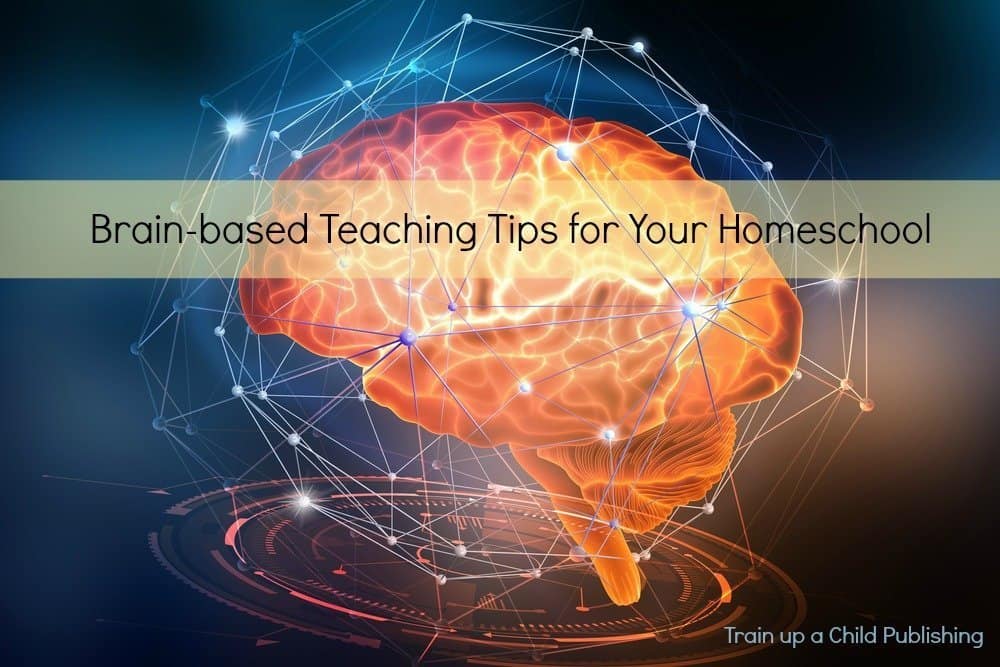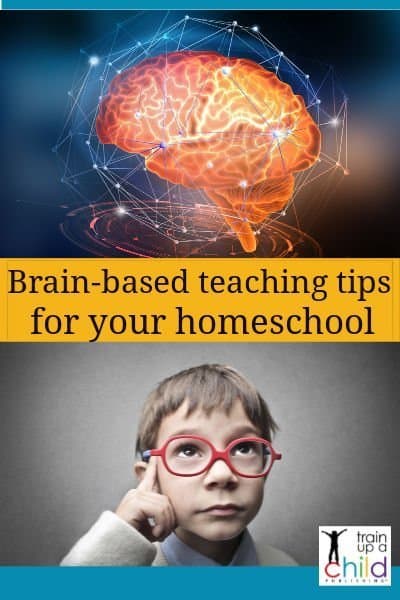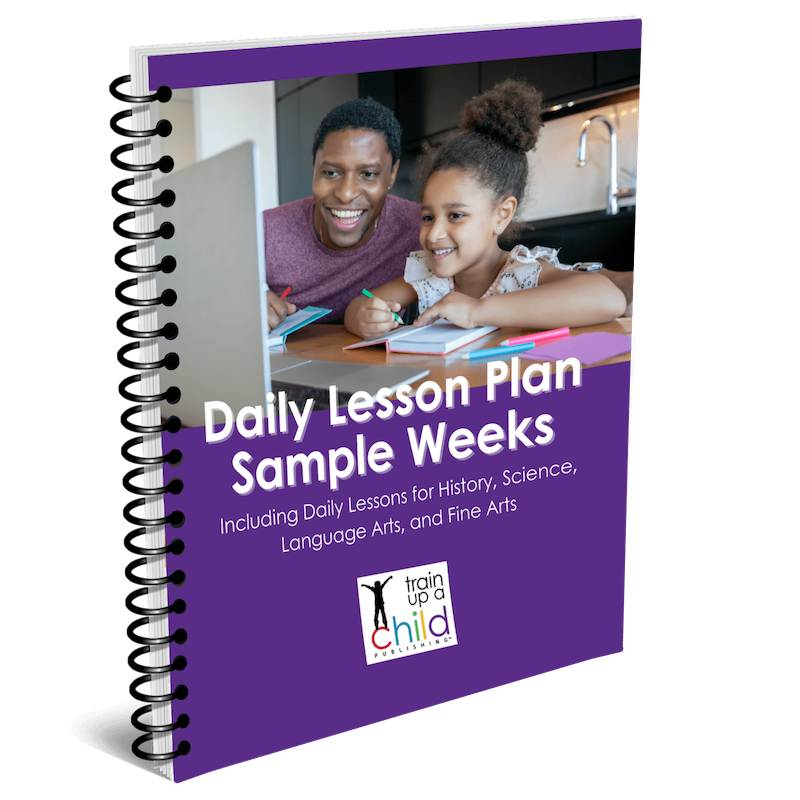Brain-based Teaching Tips for Your Homeschool

Have you seen the terms “brain-based teaching strategies” and ”brain-based learning” around a lot lately? It’s not just for classroom use – brain-based teaching is for homeschool, too!
There’s a lot of buzz about this in the public and private school systems, so why not in homeschooling circles? I know you want to do everything you can to help your kids remember what they are hearing and doing, so let’s take advantage of recent research and teach how kids’ brains learn. So to that end, this is the first post out of four where I share brain-based teaching strategies for homeschooling.
I admit it. I geek out over learning research. Especially when I’ve seen the results of putting it into practice.
And if your homeschooling becomes more effective in less amount of time, then it’s going to free up time to devote to other things. Don’t forget, I believe you can bring your kids’ homeschool education to life and still balance the rest of your responsibilities — and using brain-based teaching for homeschool is one way to help you do it!
So what exactly is “brain-based teaching, ” you ask?
Brain-based teaching is using teaching strategies for your homeschool that align with how your children’s brains learn.
According to brain research, if you’re successful in teaching how your kids’ brains work, your homeschool students will be more engaged, and learning will be more likely to stick.
This first principle of brain research that I will tell you about today is so important, so crucial, that I will describe it in detail. I’ll give you many examples to “say this, not that, ” so hopefully you’ll understand exactly what to do to help your kids in this way. Click on the links at the bottom of this post to read other brain-based teaching strategies for your homeschool.
Brain-based Teaching Tip #1 for homeschool: Help your child have a vision that he or she can succeed.
According to Dr. Eric Jensen of Jensen Learning, research shows that one of the most important indicators of school success is what the student believes about his potential for success. [This principle is based on the following research: Hattie, J.A. (2009). Visible Learning. Routledge, London, UK.]
Does that surprise you that what your student believes about his potential for success is more important than… his vocabulary? Math scores? His reading level? It surprised me, too!
So if your student’s belief in his ability to learn is crucial to his success, then one of your most important jobs as his teacher is to help your student believe that he can succeed in homeschooling.
Maybe your students love to learn and are already confident in their academic abilities. Or maybe you have a student who struggles. One who has a difficult time learning. This is the child for whom you need to read this post.
Side note: I am not discussing children with learning disabilities in this post. I’m not qualified to know how much this topic could influence a child who learns differently. If you are a mom of a differently-abled child, please know that I don’t want to sound as if I am minimizing your child’s issues.
So how can you help your students believe they can be academically successful?
Here are ways you can use brain-based teaching in your homeschool – help your children believe they can be successful. Here’s how:
- Believe in them and demonstrate that through your positive, specific praise and encouragement
- Help them set academic goals that are a little beyond their reach and give them the tools to reach them
- Make your homeschool a safe place where your students are free to learn and make mistakes — even if they don’t always live up to your and their expectations
- When there are issues with motivation and getting the work done, enlist their help to deal with the issue
We’ll take these one at a time.
1. Believe in your children’s abilities
One of the most fascinating research findings on the brain is that it can change. They call this neuroplasticity.
Hear this — our brains, our “level of intelligence”– is not fixed, even though for many years we were taught that what intelligence we were born with (or developed by about age three) we’d have forever. Not true!
We know now that we can improve our intelligence and abilities even into adulthood!
Pretty phenomenal, don’t you think?
And if we can do this as adults, you know your children’s brainpower and intelligence aren’t set in stone, either.
So don’t give up on your kids.
Everyone matures in different areas at different times, so do your best to stay optimistic about your kids’ abilities.
In other words, don’t let your thoughts default to, he’s lousy at math, or she can’t write a lab report that makes any sense.
In fact, as parents, we help our children form their ideas of their ability. What we say to them, how we treat them when they don’t do as well as we’d like …. you, homeschooling mom and dad, more than anyone else, have the power to help your students believe they can be successful.
And if research shows that what your children think about their ability shapes their ability, you need to do everything you can to help them see themselves as successful. This is by far the most important brain-based teaching method for your homeschool.
But how do you do that?
So how do you use affirming, confidence-building words with your student? How can your words help instill confidence that he can succeed?
You pay attention and praise your child in specific terms when he or she does something noteworthy. You base your praise on real information, making it more believable to your child and less like, “you are my mom, so you have to say that.”
Point out the positives of behavior, in specific terms, such as:
- Instead of just saying this: I’m so proud of you.
- Say something like this: I love the way you had such good concentration when you worked on your copy work today. I’m proud of you for working so carefully and neatly, and your copy work is excellent because of your effort.
You’re probably used to saying, “Good job!” to your new reader as he’s learning to decode words and learn sight words. But can you be more specific?
- Instead of saying: Good job reading!
- Say something like this: You’ve made such progress in reading since last year! Your diligence in reading every day and carefully sounding out words is paying off! Your reading is getting much smoother and more confident.
Here’s another example. When a student does well on a test:
- Instead of saying: Great test!
- Say something like Woohoo! Your persistence in putting in that extra work to go over your homework mistakes this week was a great strategy that helped you do much better on your Algebra test!
When you praise your kids for specific, positive efforts, you help them make the connection between their efforts and their successes.

2. Help your students set academic goals that are a little beyond their abilities and give them the tools to reach them.
By helping your students set goals a little beyond what they think they can do and helping them reach those goals, you are reinforcing that they can be successful. Essentially, they are proving to themselves that they can do more than they thought they could.
This may be simply learning to write a solid paragraph for a younger child. For an older child, it could be a big project with several different parts. For a high school student, it could be writing a research paper for the first time.
In all of these examples, you’d break the task down into small steps and set a deadline for every step. Work together with your middle school student, and teach your high school student to do this themselves. (And then remember, like Ronald Reagan so aptly said, ‘Trust, but verify.”)
Encourage persistence, and praise your kids like crazy for their hard work when they reach their goals! Then set the bar a little higher in the future.
Don’t be afraid to challenge your students. Help by giving them the tools to succeed, and then praise them for how they accomplished the task through their hard work when they do. This builds their confidence, so they are ready to try the next hard thing.
And even better? They begin to believe in themselves!
3. Huge brain-based teaching method for your homeschool: Make your homeschool a safe place for your student to “fail” or not do as well as you and he expected.
Help your kids know that it’s okay to make mistakes, and they won’t get blamed or shamed because of them.
This may take a shift in attitude and behavior on your part first. For example, were you met with disappointment or even disgust as a child when you didn’t do well in school?
If so, it could be hard for you not to react similarly, especially if you feel your child wasn’t doing his best.
Unfortunately, we all bring a little (or a lot of) baggage with us into parenting and homeschooling. That’s okay. You can work through this.
Remember that your students’ brains are still in the process of maturing, and you can help them develop more of a “learning mindset” by the way you deal with those less-than-successful outcomes.
Essential brain-based teaching rule for your homeschool: Teach yourself and your children how to look at failure differently than you/they may have looked at it in the past.
Editor’s note: this post contains affiliate links. Should you make a purchase using one of my affiliate links, we might make a few cents commission on your purchase, at no extra cost to you. We use this for coffee. And we thank you for it!
This is a “mindset” issue — and what we tell ourselves is true influences our behavior. So if you believe you’re a bad teacher, you might be a bad teacher, unless you learn more about teaching and learn to think differently about your ability.
Sometimes we are in the habit of thinking this way, and then we are closed off from learning more. But you have the power to choose to learn more and become a better teacher. (And who can’t improve by learning more?)
If this is something you struggle with, I suggest you read Mindset, by Carol Dweck. This can help you understand the importance of how you look at things and “what you tell yourself” about them.
Not only will this help YOU to look at life more positively, but this will also give you the tools to teach your children to look at life and themselves more positively. This is the gift that keeps on giving!
The ideas in this book will help you provide a SAFE environment for learning. A place where it is okay not to do things perfectly every time.
Here’s an example of how you might be positive with a student who doesn’t feel he’s a good writer:
- You know, Sam, one definition of the word “Fail” is First Attempt In Learning. I know you don’t think you are a good writer. But you don’t know how to write an essay yet; you are just learning. With this essay assignment, you’ll write a few different drafts, and each draft will improve. It will take effort, but I know you can master this. I’ll help you. Before you know it, you will have this down. Writing just takes effort and practice, but I know you can do it!
Here are some more examples of what you might say to a student who didn’t do well on something:
- I love how you jumped in to do your Algebra lesson today. Yes, I know you missed several questions, but that shows us exactly what we need to work on. Your persistence in working on this until you have it figured out does not only help you with this algebra — it’s also going to pay off big time in college and in your future career.
- I know you worked hard on this and your score disappoints you. But that’s okay. It’s only a number. We will take it question by question over the next day or two, and you’ll get this with regular review. You just don’t get it YET.
4. When there are problems getting the work done, involve your student in strategizing ways to work on the issue.
- I can see it is difficult for you to learn Spanish, making you want to avoid it. But since avoiding it is not an option, how can we strategize, so you complete your Spanish lessons more regularly?
- Okay, we’ll do a Spanish lesson every day right before lunch. We’ll set the timer and stop after 15 minutes. Then after lunch and our break, we’ll have a short review of what you learned before lunch. We’ll stay on that schedule for three weeks. Then see if it becomes easier to get your Spanish done.
When you believe in your student, and he begins to believe in himself through his own successes, the magic happens!
If you use brain-based teaching tips like this all-important first one, you’ll see more cooperation and motivation to learn, more enjoyment and engagement in school, and you’ll become more of a coach and a cheerleader than a grouchy taskmaster.
So what part of this post is a new idea or resonates with you? Tell me in the comments below!
Related Posts:
Teach your children to believe in themselves.
#3 Brain-based Teaching Tip #3: Turn Listeners into Learners by Priming Their Brain




This is an awesome article, Dana! Thank you for posting! I’ve done a lot of research lately on brain-based learning through music education. Here’s an article I published about it — it’s called “Build Your Child’s Future NOW: How Child-Parent Play Enhances Brain Function.” https://www.mymusikathome.com/blogs/news/building-your-childs-future-now
Thanks for the compliment, Kathryn! The more reading I’ve done about brain-based learning and teaching, the more captivated I am. Do you feel the same? I’ll enjoy reading more about it from your perspective as well; thanks for including the link to your article and for stopping by!
Even though I don’t have a school-aged child yet, this is helpful information in general to apply as children are always learning! Thank you!!
Thank you, Aliece! Glad it was useful!
This is great, Dana, thanks! Very applicable in lots of other situations, too! Ö
Thank you, Rose!
“Everyone matures in different areas at different times.” Thank you for reminding me of that truth! It is easy to forget in the day to day challenge of teaching my 17 year old Asperger’s ADHD, dyslexic, dysgraphic student. Sometimes I wonder if we will ever get through high school-whew! And he has recently begun talking about home schooling college! Help! (just kidding :), we will do a college degree the same way we have done every other step, one day at a time). Thanks again for your wisdom Dana!
Oh, Shelly~ I’m so happy that it encouraged you! You do have your hands full. One day at a time is certainly the wise way to live. <>
This is what I need to learn and apply. Thank you. I will be checking out that book as well.
You’re welcome, Lisa! I think we all would do well to practice this kind of encouragement with our kids. Glad to have helped.